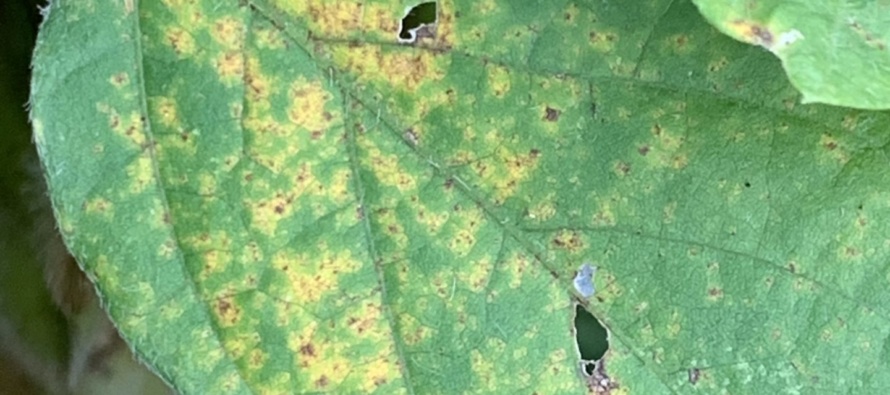Mississippi Soybean Rust Foliar Disease Update: September 5, 2020

Related Articles
- 2010 Soybean And Corn Variety Trial Data 3
- Rice Variety Trial Results For 2010, Plus Rice Research Report 0
- Evaluation of Peanut Prescription Rx Program in Mississippi 0
Latest Tweets

Soybean rust as observed from the top of the leaf. However, the bottom of the leaf, or leaf underside is where the pustules present themselves.
Over the past seven days, soybean rust has been observed throughout a majority of the state of Mississippi. Note that the information outlined below may change over the course of the next week. If and when that does occur we will attempt to update the information on an as needed basis. The most up-to-date information on the distribution of soybean rust in MS as well as neighboring states can be located at: https://soybean.ipmpipe.org/soybeanrust/
Over the past several weeks I’ve had a lot of people say “I haven’t heard much about soybean rust”. I think that’s a pretty common response since soybean rust has not been much of a yield concern since first observed in MS. Soybean rust is one of those diseases that typically occurs at advanced growth stages (R6+). Over the past few years, soybean rust has been widespread in the state, but the likelihood of yield losses as a result of the disease have been non-existent simply because the disease has been observed at advanced growth stages later in the season. The general line of thinking behind soybean rust is that the disease really does not like high temperatures and therefore has not been a big threat due to some of our summer time high temperatures. However, this year in particular, with a mild winter and an early tropical system in June I suspect that a good bit of soybean rust inoculum was dispersed across MS and has resulted in what has tended to be some earlier than normal infection throughout the state.
Scouting for soybean rust can be rather difficult. The bulk of the time, soybean rust is present in low levels in the lower-to-middle canopy, making scouting for the disease difficult. when the disease can be present within the canopy in extremely low levels is difficult. The lesions presented on the upper leaf surface can be confused with several other diseases (bacterial blight, downy mildew, Septoria brown spot). On the upper leave surface, lesions look like small pinpoint lesions that can range in color from brown to maroon with a yellow halo around the cluster of lesions. However, observing the underside of the leaf is the most important part. On the bottom of the leaf (the leaf underside), lesions develop a raised appearance, a pustule, and when sporulating will look like small sand grains coming out of a tiny volcano. The color of the raised pustules can range from light tan (young, fresh) to dark brown/maroon (old) depending on the age of the lesion. The best way to observe the pustules with a 20x hand lens.

Observing the bottom, or underside of the leaf is the best way to determine if soybean rust is present or not.
Managing soybean rust is possible with fungicides; however, determining if soybean rust is a threat in a given field is difficult since scouting can require a lot of effort. But, soybean fields that have reached R6 are generally considered to be “safe” from any yield losses that may result from soybean rust.
In field situations where soybean may be as young as R3/R4, a fungicide should be applied. However, wait until something on the order of R4.5 so as to maximize the residual of the fungicide product. In these situations, a dual mode of action fungicide (strobilurin + triazole) will likely be the most beneficial fungicide choice. The residual with this type of product selection should provide 21 days of protection and get soybean well into the R5 growth stages.
In field situations where soybean is younger than R5.5 and have NOT received a fungicide to this point in the season, then a fungicide that contains a stand-alone triazole product could be economically beneficial. A triazole fungicide applied in this type of situation should provide two weeks of protection and get the crop to R6 when soybean is
The best source of information for product selection can be found at:
The information regarding fungicide efficacy in the pdf publication has been put together by plant pathologists from across the nation and is a good course on the response of soybean to several different diseases. In addition, note that tebuconazole is one alternative that is not included in the pdf. The PHI on tebuconazole is 21 days pre-harvest. However, be mindful that tebuconazole can produce phytotoxicity; however, this has not been correlated to a yield reduction as a result of the appearance of injury. Be mindful of the pre-harvest interval on some of the products in this list. In most cases the triazole products have a limited PHI and cannot be applied after R5 in at least one case.
In addition, make note that the long-range forecast for the next ten days includes some temperatures that will be extremely conducive for more widespread development of soybean rust. Waiting for stinkbugs to build to threshold would not be out of the question in these situations outlined above to limit the number of trips across the field. However, follow the entomologist’s recommendations for stinkbug thresholds.




Let me tell You a sad story ! There are no comments yet, but You can be first one to comment this article.
Write a comment